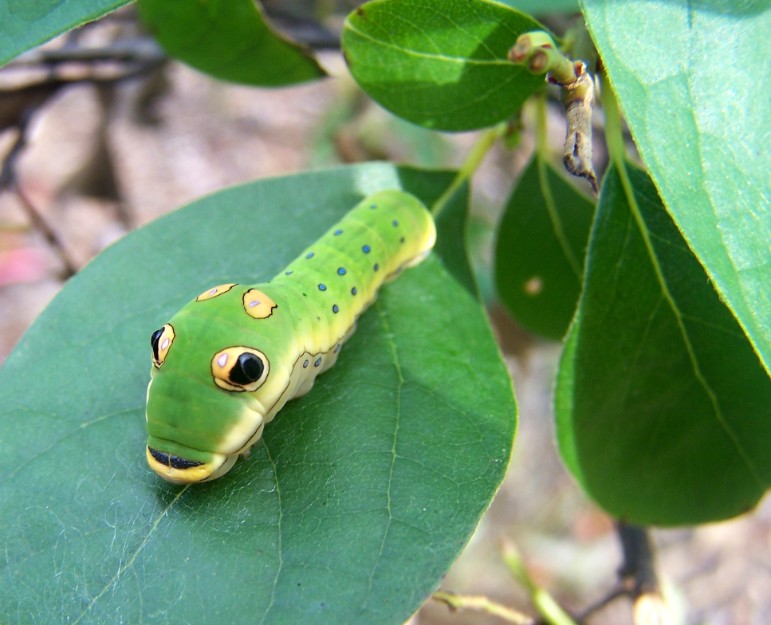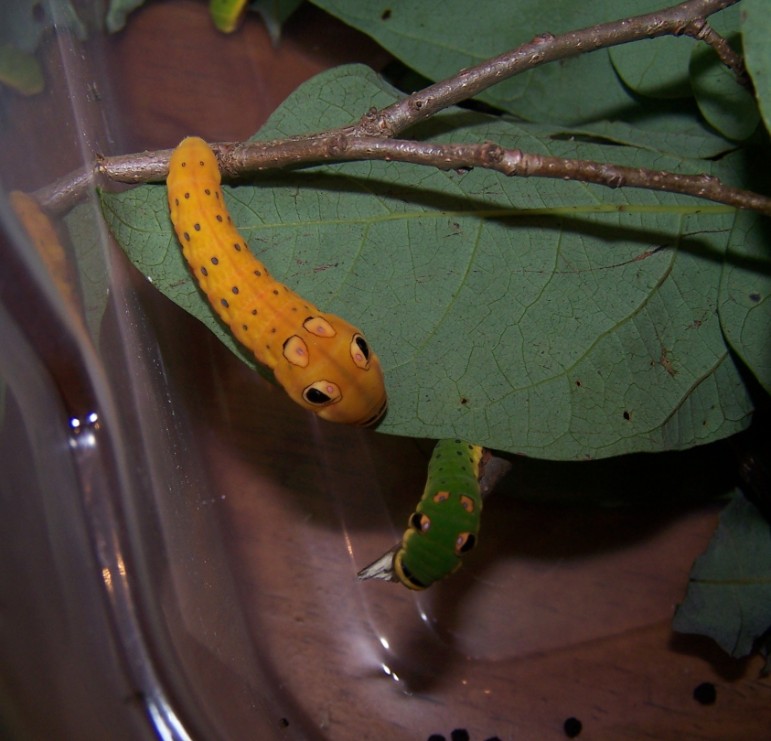Eggs, Larvae, Pupa and then Adult- this amazing metamorphosis goes on every day without us.
Plants - host and nectar and what that means?
Host Plants - plants a butterfly needs to lay its eggs on and the Larvae needs to eat
Nectar Plants - plants a butterfly needs to "drink" from to get nourishment
Do I have to let the caterpillar eat my plants? Yes, if you ever want Butterflies!
How can I have butterflies in my yard? Plant items from the lists below and come to a class at Flying Flowers of Beagle Ridge.
Here are pictures of Monarch eggs in the flowers and on the leaves of tropical Milkweed.
This is a Tulip Popular Tree which was still in a pot when a Tiger Swallowtail laid her eggs.
Spicebush Swallowtail eggs. Notice how the leaves are cut and curled. Once the larval hatch, they cut and roll the leaves around themselves to protect themselves.
Next the Larvae - they are also referred to as Caterpillars in this stage
Notice they are two different sizes? The top one is a 2nd Instar the bottom a 3rd Instar. Each time they molt they will change a bit and get larger. Spicebush Swallowtails change dramatically.
This is a Spicebush Swallowtail. He becomes green to camouflage but the eye spots will scare away predators. Those are not eyes! His eyes are actually down in the beige part by his mouth.

Notice the color changes, the peachy colored one is getting ready to pupate.

The following is a list of Butterflies and what their larvae eat- remember as a caterpillar they only eat, as an adult butterfly they drink. These wonderful insects will eat the Host plants as a caterpillar and as such if there is something you want to use such as Parsley, plant extra for them and be sure to share.
So in order to make your yard a habitat for Butterflies you will need plants for all the stages of their life.
Butterflies and their required Host Plants
From A Regional Guide to Butterfly Gardening in our area
Region 6
Alabama, Arkansas, Florida, Georgia, Kentucky, Louisiana, Mississippi, North Carolina, South Carolina, Tennessee, Virginia
- Black Swallowtail
(Papilio polyxenes) - Fennel (Foeniculum vulgare)
- Parsley (Petroselinum crispum)
- Carrot (Daucus carota)
- Dill (Anethum graveolens)
- Spicebush Swallowtail
(Papilio troilus) - Spicebush (Lindera benzoin)
- Sassafrass (Sassafrass albidum)
- Tiger Swallowtail
(Papilio glaucus) - Wild Cherry (Prunus spp.)
- Poplar (Populus spp.)
- Pipevine Swallowtail
(Battus philenor) - Pipevines (Aristolochia spp.)
- Buckeye
(Junonia coenia) - Snapdragon (Antirrhinum spp.)
- Verbena (Verbenaceae)
- Pearl Crescent
(Phyciodes tharos) - Asters (Asteraceae)
- Monarch
(Danaus plexippus) - Milkweed (Asclepias spp.)
- Cloudless Sulphur
(Phoebis sennae) - Wild Senna (Cassia spp.)
- Gulf Fritillary
(Dione vanillae) - Passion Vine (Passiflora spp.)
- Red-spotted Purple
(Limenitis astyanax) - Willow (Salix spp.)
- Wild Cherry(Prunus spp.)
FLOWERS (Nectar
Sources)
The following are excellent sources of nectar for your Butterfly Garden and can
be purchased at many retail nurseries and garden centers throughout the
country. Plant these in abundance where regionally available. Although many of these are annuals at the farm they are worth planting as nectar producers. The items in Red are usually available at Flying Flowers, items in Blue should be started from seed.
|
|